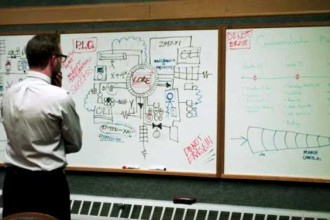Amish, Luddites and the March of Technology

Let’s start off with the Amish.
Yes, you’re in the right place, and yes, this is the opening to a technology column. Theirs is a community about which I’ve been thinking, both since a recent vacation to Lancaster, Pennsylvania, and, more recently, after a discussion about so-called digital natives and acceptance of new technologies.
I’ll start by noting that, like any marginalized group, we tend to see the Amish as a series of stereotypes and assumptions rather than as a living people with a living, growing culture. I’m sure that when you read the very word here, a few images came to your mind. The horse and buggy. Black clothes. A butter churn. During a visit to the Amish Experience museum, I learned the latter — immortalized in a Weird Al song (“I’ve churned butter once or twice, living in an Amish paradise”) is not so big a part of the current Amish life as it once had been. How do Amish people get butter if they don’t churn it themselves? The same way I do: They buy it at Costco. In fact, the Lancaster Costco parking lot includes accommodations for horse and buggy parking to serve this part of their clientele. When they get the butter home to a house that still doesn’t have electricity, they can keep it cold in a propane-powered refrigerator. Does this surprise you? It shouldn’t. The Amish community may evaluate and adopt technology more slowly than many others, but that doesn’t mean they don’t believe in technology.
A plow is technology.
A horse-drawn buggy is technology.
Even that old butter churn is technology.
What does this have to do with our lives as AV technologists, especially in these challenging times? We have two big lessons:
Even those resistant WILL embrace technology if it fits their life and workflow.
Buying butter in bulk saves hours of manual labor, freeing time for other chores or activities. A gas-powered fridge allows better and more efficient food storage without sacrificing the self-sufficiency of living off the power grid. These are choices that don’t disrupt a way of life but enhance it. We need to look for the same with our clients, with their corporate culture and their workflow. As more work moves from the huddle room to sometimes ad hoc home offices, we now need to look at how things fit into personal cultures and lifestyles. Do we need to optimize audio and video quality with an installed gear, or do we focus on more portable fit-outs for ad hoc spaces in homes without room for a dedicated office? Do we need to make allowances for variable bandwidth?
It is effortless for us to look at our culture, biases and capabilities as universal. This can make us look down at those not willing or able to embrace what we see as the best technical solutions. Don’t assume that someone who is not adopting the same tech types at the same pace as you will not embrace any.
We need to accommodate many possible audiences.
The decision to include buggy parking at a Costco is a choice based on the local client base. To assume that an entire population segment comprises Luddites who will say no to any engagement with technology would risk losing them as customers. With this, we come to our second topic: Luddites.
The term “Luddite” has come to stand for any person opposed to technology in general — the person who refused an iPhone, who won’t use their camera in a video chat, the one who uses a map instead of GPS. Many of us have forgotten that the Luddites were originally an anti-industrial movement in the early nineteenth century. They famously smashed newly introduced power looms not as a statement against the idea of technology, but as a reaction to the societal upheaval and lost jobs caused by industrialization. What’s always struck me about the Luddites is that, while they weren’t right about the ability to stop progress, they also weren’t wrong about progress having a harmful side. It’s harm which society was slow to mitigate.
Why are the Luddites on my mind today, and what does it mean for the AV industry? I see one of the biggest technological threats coming from the combination of AI with prevalent cameras and microphones. Is refusing to use a camera irrational technophobia, or is it rational safeguarding of privacy? What about opting out of Google/Amazon/Apple voice control?
This brings us to the next big point about adoption:
Not everyone who refuses a technology is irrational.
The Amish adopt technology slowly and deliberately because it doesn’t always fit their culture or their needs. Luddites destroyed technology because it was harming them economically and socially. If we’re going to work with people who have resistance, we need to understand its source and see how we can best accommodate them.
At the end of the day, that is the biggest lesson to learn from Amish or from Luddites: that our faith in technology is not universal, often for a good reason. At the end of the day, we need to do what we’ve always done: Listen, ask questions and always be ready to reexamine our assumptions.




